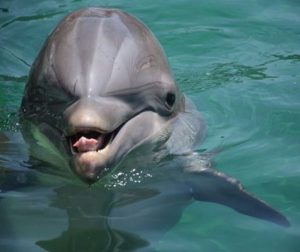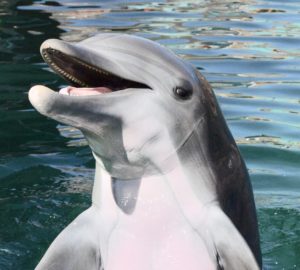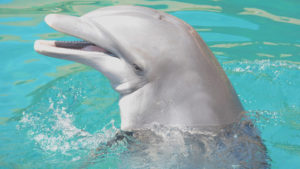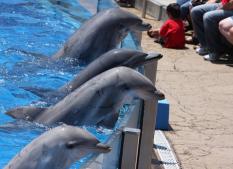ADLA Campaign against Dolphin Captivity
 The practice of holding whales and dolphins in captivity is an increasingly controversial issue. Opposition to this outdated practice has grown across the nation and around the world, fanned by the release of documentaries such as Blackfish and The Cove, and propelled by a global grassroots movement concerned with the impacts these activities have upon both captive and wild dolphins.
The practice of holding whales and dolphins in captivity is an increasingly controversial issue. Opposition to this outdated practice has grown across the nation and around the world, fanned by the release of documentaries such as Blackfish and The Cove, and propelled by a global grassroots movement concerned with the impacts these activities have upon both captive and wild dolphins.
In 2016, a ‘Swim-with-the-Dolphins’ (SWTD) attraction opened near Scottsdale, Arizona on Salt River Pima Maricopa Indian Community land. ADLA has been deeply involved in opposing this facility, called Dolphinaris, since January 2016 when the news broke that this project was moving forward. ADLA has not traditionally campaigned on dolphin issues because of our focus on local animal welfare issues (and marine mammals are not a natural part of the desert environment!), but because of the construction of this new captive dolphin facility locally, we were compelled to act.
In August of 2017, ADLA and the Animal Welfare Institute (AWI) launched a digital campaign aimed at discouraging the public from buying tickets to attractions that exploit captive dolphins. A video by Nanna Påskesen and marketed by Elected Digital’s Josh Zaragoza, contrasts the lives of dolphins in the wild with those in confinement.
In October of 2017, ADLA, AWI, and Plea for the Sea learned of the death of Bodie, a young dolphin at Dolphinaris. The seven-year-old bottlenose dolphin reportedly died in September at the facility. Our organizations began actively investigating Bodie’s death, including specific details about the nature of his illness, length of treatment, and to determine whether other dolphins had become ill or have died since Dolphinaris opened. Our groups had repeatedly cited concerns about the welfare of captive dolphins being housed in Arizona’s desert climate. The environment is a potential source of Valley Fever and other fungal diseases that can lead to deadly respiratory infections in dolphins whose immune systems are weakened by the stress associated with captivity. Captive dolphins are highly susceptible to respiratory ailments, and the groups forewarned officials, the media, and the public that this might be a probable outcome of housing dolphins in a dusty desert environment.
 In May of 2018, just eight months after the death of Bodie, another dolphin died. Alia was a ten year old dolphin who according to Dolphinaris, “had displayed some unusual behaviors in the last few days” and “was being monitored.” Two tragic deaths at Dolphinaris in less than a year. Following Bodie’s death from fungal infection in September 2017, ADLA and other groups expressed concern to Dolphinaris and government agencies regarding the health and welfare of the remaining dolphins. Bodie’s death was tragic and preventable and it’s likely that Alia also died from respiratory disease. Dolphinaris refused to provide the public with accurate, comprehensive information regarding the illness and death of Bodie and Alia, as well as information on the current health status of its remaining captive dolphins.
In May of 2018, just eight months after the death of Bodie, another dolphin died. Alia was a ten year old dolphin who according to Dolphinaris, “had displayed some unusual behaviors in the last few days” and “was being monitored.” Two tragic deaths at Dolphinaris in less than a year. Following Bodie’s death from fungal infection in September 2017, ADLA and other groups expressed concern to Dolphinaris and government agencies regarding the health and welfare of the remaining dolphins. Bodie’s death was tragic and preventable and it’s likely that Alia also died from respiratory disease. Dolphinaris refused to provide the public with accurate, comprehensive information regarding the illness and death of Bodie and Alia, as well as information on the current health status of its remaining captive dolphins.
In January of 2019, ADLA AWI, and its partner groups learned that Khloe, a ten year old bottlenose dolphin reportedly died on December 30, 2018. In just over two years, one third of the dolphins held captive at Dolphinaris were now dead. ADLA, AWI, and other groups continued to seek accurate information from Dolphinarisand government agencies regarding the health and welfare of the remaining dolphins. Dolphinaris released a statement that Alia died from septicemia from an acute bacterial infection. However, despite our requests, Dolphinaris refused to release any necropsy reports. Our organizations urged Dolphinaris to finally do the right thing by releasing its remaining dolphins to a seaside sanctuary before another death occurred. Arizona Republic columnist Ed Montini wrote an excellent piece on the death of Khloe. This was his third article on dolphins that had died at Dolphinaris. Based on this facility’s poor record we were very concerned that it wouldn’t be the last.
infection. However, despite our requests, Dolphinaris refused to release any necropsy reports. Our organizations urged Dolphinaris to finally do the right thing by releasing its remaining dolphins to a seaside sanctuary before another death occurred. Arizona Republic columnist Ed Montini wrote an excellent piece on the death of Khloe. This was his third article on dolphins that had died at Dolphinaris. Based on this facility’s poor record we were very concerned that it wouldn’t be the last.
Just one month following Khloe’s death, another dolphin was dead. Kai, a 22-year-old dolphin, died after his condition began deteriorating and he had difficulty swimming, eating and breathing, according to a statement from Dolphinaris. ADLA and AWI again attempted to seek information on these senseless deaths and the status of the remaining dolphins. For the first three dolphins that died, AWI and ADLA wrote to USDA APHIS (and initially to Dolphinaris itself) requesting  necropsy reports but were told that APHIS had not retained any of these records. Following this fourth death, AWI submitted a letter to APHIS stating that ‘it is crucial that an investigation into the conditions at Dolphinaris and a full health assessment of the remaining dolphins be conducted by a team that includes an expert APHIS veterinarian and an expert NGO veterinarian, as well as other external specialists.’
necropsy reports but were told that APHIS had not retained any of these records. Following this fourth death, AWI submitted a letter to APHIS stating that ‘it is crucial that an investigation into the conditions at Dolphinaris and a full health assessment of the remaining dolphins be conducted by a team that includes an expert APHIS veterinarian and an expert NGO veterinarian, as well as other external specialists.’
In February 2019, following years of public record requests, negative media reports, and protests by hundreds of citizens, Dolphinaris transferred its remaining dolphins to a sea pen in St. Thomas and permanently closed its doors. In just over two years, half of the dolphins held captive at Dolphinaris were dead. Although we still don’t know what caused the deaths of four dolphins at Dolphinaris within an 18-month period, thankfully it is out of business, and no more animals will die at this captive facility.
History and Background
Dolphinaris was the first of two such facilities that Mexico-based company Ventura Entertainments is seeking to build in the United States. Already, another Mexican company, Dolphin Discovery, has expanded into the US and is the largest operator in the Caribbean, profiting from the exploitation of dolphins in these captive SWTD programs. According to Courtney Vail, a local biologist and policy expert who was instrumental in alerting the public to the impending development of this captive dolphin program in Arizona, there are approximately 31 facilities in the United States holding over 560 dolphins in captivity, with at least 80% of these parks allowing some form of interaction between captive dolphins and patrons. Read Captive Dolphin Fact Sheet.
Holding whales and dolphins in confinement for entertainment has come under intense scrutiny and global condemnation. An increasing public aversion to this practice is evidenced by a 2017 poll conducted here in Arizona that reveals that nearly 50% of the public opposes the confinement of dolphins to small concrete pools so that people can swim with them.
Public attitudes are changing. However, despite the increasing sensitivity to holding killer whales in captivity and some progressive movements within the captivity industry to respond to changing public opinion– including the decision by SeaWorld to no longer breed or export its orcas and eliminate orca performances—there is a recent surge in the development of new SWTD programs within the United States. That is why ADLA strongly believes that our ability to challenge a new captive dolphin program here in Arizona is important to stemming this negative trend elsewhere in the U.S. Here in Arizona, we are on the front-lines of the battle to fight dolphin captivity.
We believe that there are many alternatives available to satisfy our desire to see, or learn about, these amazing creatures. Responsible whale and dolphin watching opportunities are close to Arizona, where dolphins can be viewed swimming free in their natural environment. Technology, such as virtual and augmented reality, provides us with a myriad of options and potential to immerse ourselves in creative learning opportunities. Many species are appreciated, respected, and protected in their natural homes without confining them to captive environments.

